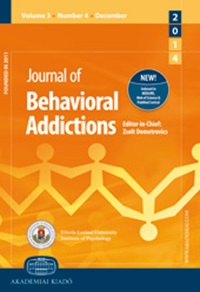Treating internet use disorders via the internet? Results of a two-armed randomized controlled trial
IF 6.6
1区 医学
Q1 PSYCHIATRY
引用次数: 0
Abstract
Abstract Background and aims Internet Use Disorders (IUDs) are emerging as a societal challenge. Evidence-based treatment options are scarce. Digital health interventions may be promising to deliver psychological treatment to individuals with IUDs directly in their online setting. The aim of this study was to evaluate the efficacy of a digital health intervention for IUDs compared to a waitlist control group (WCG). Methods In a two-armed randomized controlled trial, N = 130 individuals showing IUDs (Internet Addiction Test; IAT ≥49) were randomly allocated to the intervention group (IG; n = 65) or WCG ( n = 65). The intervention consisted of 7 sessions based on cognitive behavioral therapy. The primary outcome was IUD symptom severity measured via the IAT at post treatment 7 weeks after randomization. Secondary outcomes included IUD symptoms (Compulsive Internet Use Scale; CIUS), quality of life, depressive and anxiety symptoms, and other psychosocial variables associated with IUDs. Results Participants were on average 28.45 years old ( SD = 10.59) and 50% identified as women, 49% as men, and 1% as non-binary. The IG ( n = 65) showed significantly less IUD symptom severity (IAT) ( d = 0.54, 95% CI 0.19–0.89) and symptoms ( d = 0.57, 95% CI 0.22–0.92) than the WCG ( n = 65) at post-treatment. Study attrition was 20%. Effects on all other secondary outcomes were not significant. On average, participants completed 67.5% of the intervention. Discussion and Conclusions A digital health intervention could be a promising first step to reduce IUD symptom severity.通过互联网治疗网络使用障碍?一项双臂随机对照试验的结果
背景和目的互联网使用障碍(IUDs)正成为一个社会挑战。循证治疗方案很少。数字健康干预措施有望在网上直接向宫内节育器患者提供心理治疗。本研究的目的是评估与等待名单对照组(WCG)相比,宫内节育器数字健康干预的疗效。方法采用双臂随机对照试验,N = 130例iud (Internet Addiction Test)患者;IAT≥49)被随机分配到干预组(IG;n = 65)或WCG (n = 65)。干预包括以认知行为疗法为基础的7个疗程。主要结局是在随机分组后7周通过IAT测量IUD症状严重程度。次要结局包括宫内节育器症状(强迫性网络使用量表;CIUS)、生活质量、抑郁和焦虑症状以及与宫内节育器相关的其他社会心理变量。结果参与者的平均年龄为28.45岁(SD = 10.59), 50%为女性,49%为男性,1%为非二元性别。IG组(n = 65)治疗后IUD症状严重程度(IAT) (d = 0.54, 95% CI 0.19-0.89)和症状(d = 0.57, 95% CI 0.22-0.92)均明显低于WCG组(n = 65)。研究流失率为20%。对所有其他次要结局的影响不显著。参与者平均完成了干预的67.5%。讨论与结论数字健康干预可能是降低宫内节育器症状严重程度的有希望的第一步。
本文章由计算机程序翻译,如有差异,请以英文原文为准。
求助全文
约1分钟内获得全文
求助全文
来源期刊

Journal of Behavioral Addictions
PSYCHIATRY-
CiteScore
12.30
自引率
7.70%
发文量
91
审稿时长
20 weeks
期刊介绍:
The aim of Journal of Behavioral Addictions is to create a forum for the scientific information exchange with regard to behavioral addictions. The journal is a broad focused interdisciplinary one that publishes manuscripts on different approaches of non-substance addictions, research reports focusing on the addictive patterns of various behaviors, especially disorders of the impulsive-compulsive spectrum, and also publishes reviews in these topics. Coverage ranges from genetic and neurobiological research through psychological and clinical psychiatric approaches to epidemiological, sociological and anthropological aspects.
 求助内容:
求助内容: 应助结果提醒方式:
应助结果提醒方式:


